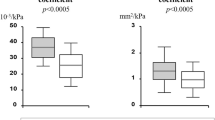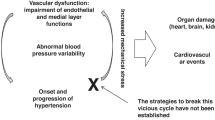Abstract
To evaluate the impact of a mild increment in blood pressure level on endothelial function, we evaluated 61 healthy volunteers (24 women, 37 men, and aged 35–50 years). All subjects underwent a blood chemistry panel to exclude any metabolic abnormalities and were submitted to a Doppler ultrasound of the brachial artery to assess endothelial function. We assessed the endothelial response to reactive hyperaemia and exogenous nitric oxide administration considering an increase in systolic blood pressure (SBP) at each 10-mm Hg interval. Our study population was divided as follows: SBP <115 mm Hg (SG1, n=13), SBP ⩾115 mm Hg and <125 mm Hg (SG2, n=20), SBP ⩾125 mm Hg and <135 mm Hg (SG3, n=13) and SBP ⩾135 mm Hg and <140 mm Hg (SG4, n=15). We found a significant difference in flow-mediated dilation among SG2, SG3 and SG4, 16.2±5.6, 13.4±5.2 and 11.5±3.6%, P<0.05, respectively). After nitrate administration, we observed a nonsignificant decrease in brachial artery dilation among groups, P=0.217. Our data showed in a healthy normotensive population, without any risk factor for atherosclerotic disease that small increases in SBP but not in diastolic blood pressure may impair endothelial function even in subjects considered as high-normal, meaning that this population deserves more attention than usually ascribed to intervene and prevent complications, as endothelial dysfunction may represent an early change in those who develop hypertension later in life.
This is a preview of subscription content, access via your institution
Access options
Subscribe to this journal
Receive 12 digital issues and online access to articles
$119.00 per year
only $9.92 per issue
Buy this article
- Purchase on Springer Link
- Instant access to full article PDF
Prices may be subject to local taxes which are calculated during checkout



Similar content being viewed by others
References
Chobanian AV, Bakris GL, Black HR, Cushman WC, Green LA, Izzo JL et al. The National High Blood Pressure Education Program Coordinating Committee on prevention, detection, evaluation, and treatment of high blood pressure. Seventh report of the Joint National Committee on prevention, detection, evaluation, and treatment of high blood pressure. Hypertension 2003; 42: 1206–1252.
Vasan RS, Larson MG, Evans JC, O' Donnell CJ, Levy D . High normal blood pressure and risk of cardiovascular disease: the Framingham Heart Study. Circulation 1999; 100: 1–34.
Celermajer DS, Sorensen KE, Gooch VM, Spiegelhalter DJ, Miller OI, Sullivan ID et al. Non-invasive detection of endothelial dysfunction in children and adults at risk of atherosclerosis. Lancet 1992; 340: 1111–1115.
Iiyama K, Nagano M, Yo Y, Nagano N, Kamide K, Higaki J et al. Impaired endothelial function with essential hypertension assessed by ultrasonography. Hypertension 1996; 132: 779–782.
McVeigh GE, Brennan GM, Johnston GD, McDermott BJ, McGrath IT, Henry WR et al. Impaired endothelium-dependent and independent vasodilation in patients with type 2 (noninsulin-dependent) diabetes mellitus. Diabetologia 1992; 35: 771–776.
Zizek B, Poredos P, Videcnik V . Endothelial dysfunction in hypertensive patients and in normotensive offspring of subjects with essential hypertension. Heart 2001; 85: 215–217.
Pereira RBR, Ajzen SA, Plavnik FL, Christofalo DJM, Kohlmann1 NEB, Tavares A et al. Impact of cardiovascular risk factors on function and structure of vessels and heart. Hipertensão 2006; 9: 23–28.
Celermajer DS . Noninvasive detection of atherosclerosis. N Engl J Med 1998; 339: 2014–2015.
Anderson TJ, Gerhard MD, Meredith IT, Charbonneau F, Delagrange D, Creager MA et al. Systemic nature of endothelial dysfunction in atherosclerosis. Am J Cardiol 1995; 75: 71B–74B.
Cugini P, Baldoni F, De Rosa R, Pandolfi C, Colotto M, Buccarella PA et al. Higher blood pressure load (baric impact) in normotensives with endothelial dysfunction: a paraphysiological status of ‘pre-hypertension’. Clin Ter 2002; 153: 309–315.
Qureshi AI, Suri MF, Kirmani JF, Divani AA, Mohammad Y . Is prehypertension a risk factor for cardiovascular disease. Stroke 2005; 36: 1859–1863.
Cugini P, Baldoni F, De Rosa R, Pandolfi C, Colotto M, Leone G et al. The ambulatory monitoring documents a more elevated blood pressure regimen (pre-hypertension) in normotensives with endothelial dysfunction. Clin Ter 2002; 153: 167–175.
Rundek T, Hundle R, Ratchford E, Ramas R, Sciacca R, Di Tullio MR et al. Endothelial dysfunction is associated with carotid plaque: a cross-sectional study from the population based Northern Manhattan Study. BMC Cardiovasc Disord 2006; 17: 6:35.
Witte DR, Westerink J, de Koning EJ, van der Graaf Y, Grobbee DE, Bots ML . Is the association between flow-mediated dilation and cardiovascular risk limited to low-risk populations? J Am Coll Cardiol 2005; 45: 1987–1993.
Williams IL, Chowienczyk PJ, Wheatcroft SB, Patel AG, Sherwood RA, Momin A et al. Endothelial function and weight loss in obese humans. Obes Surg 2005; 15: 1055–1060.
Chan SY, Mancini GB, Burns S, Johnson FF, Brozic AP, Kingsbury K et al. Dietary measures and exercise training contribute to improvement of endothelial function and atherosclerosis even in patients given intensive pharmacologic therapy. J Cardiopulm Rehabil 2006; 26 (5): 288–293.
Pulerwitz T, Grahame-Clarke C, Rodriguez CJ, Miyake Y, Sciacca RR, Hirata K et al. Association of increased body mass index and impaired endothelial function among Hispanic women. Am J Cardiol 2006; 97 (1): 68–70.
Author information
Authors and Affiliations
Corresponding author
Rights and permissions
About this article
Cite this article
Plavnik, F., Ajzen, S., Christofalo, D. et al. Endothelial function in normotensive and high-normal hypertensive subjects. J Hum Hypertens 21, 467–472 (2007). https://doi.org/10.1038/sj.jhh.1002164
Received:
Revised:
Accepted:
Published:
Issue Date:
DOI: https://doi.org/10.1038/sj.jhh.1002164
Keywords
This article is cited by
-
Retrograde flow components in the brachial artery. A new hemodynamic index
European Journal of Applied Physiology (2012)
-
Prehypertension Is Associated With Impaired Nitric Oxide-Mediated Endothelium-Dependent Vasodilation in Sedentary Adults
American Journal of Hypertension (2011)
-
Left ventricular mass is related to endothelium-dependent vasodilation in the forearm, but not in the brachial artery, in elderly subjects: the Prospective Investigation of the Vasculature in Uppsala Seniors study
Journal of Human Hypertension (2008)



